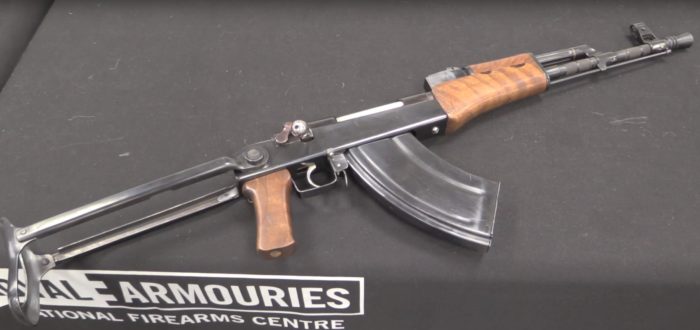This post accompanies the twenty-first in a series of collaborative videos produced with ARES Researcher Ian McCollum, who also runs the Forgotten Weapons blog and YouTube channel. Using access to unique collections facilitated by ARES, this series of videos will examine a range of interesting weapons over the coming months. Each video will be accompanied by a blog post, here on The Hoplite, and supported by high quality reference photographs. – Ed.
Jonathan Ferguson
This bizarre craft-produced weapon was acquired by the then-Ministry of Defence Pattern Room in 1996 from another UK government department. Although it arrived with no documented provenance, it was most likely produced in the tribal areas of Pakistan/Afghanistan, perhaps the famous town of Darra Adam Khel. It is an entirely scratch-built weapon inspired primarily by three extant designs. The receiver/action body is based upon that of the British Enfield Pattern 13/14 (U.S. Model of 1917) bolt-action family of rifles. This action is incorporated into what is effectively a Kalashnikov AK-inspired chassis, complete with purely decorative gas block (featuring pointless gas relief holes), fake too-short cleaning rod, and an AKS style under-folding stock. Many corners have been cut in the making of this ‘Frankengun’. For example, almost every surface is rounded off due to crude machine or hand finishing, with the result that a sharp tug on the bolt will pull it free of its retaining latch and clean out of the gun. The folding stock is extremely stiff and difficult to operate. However, it is relatively well finished with bluing and ‘decorative’ knurling on the barrel and flash-suppressor. The wooden furniture has been visibly hand-made. The rear sight was missing when the rifle entered the collection.
The magazine is patterned after that of the Bren light machine gun, but this too is scratch-built. is spuriously marked with a Russian Izhevsk arsenal mark on its baseplate. As Ian notes in the video, the lips are very shallow and barely retain a cartridge, but in fact this can be effectively loaded when fitted to the weapon, using the receiver walls as the feed lips. Thus, whilst detachable for cleaning, this is effectively a fixed magazine; even the Lee-Enfield magazine struggles to retain its cartridges when removed from the weapon whilst loaded. Due to the pronounced curve and the chosen cartridge type, only ten rounds can be crammed (with some difficulty) into what would otherwise be a 20 round magazine. The magazine design has clearly been chosen to preserve the AK-like appearance of the weapon despite its long receiver and large cartridge.
Whilst the chambering of this weapon had not been determined at the time of filming, it has since been established by means of a chamber cast and test chambering of an actual cartridge. It is now known to be 7 x 57 mm Mauser. This corroborates the sole marking on the gun, “7 MM”, which is stamped on the receiver. However, it is a relatively scarce cartridge type for the region, which favours 7.92 x 57, .303, 7.62 x 54R, 7.62 x 39, and 7.92 x 33 mm. Therefore, whereas it may have been destined for a decorative role on somebody’s wall, it probably was built as a real, firing weapon; at least in theory. As to its purpose, it has long been hypothesised that these relatively rare hybrid weapons are intended for grizzled tribal shooters who cut their teeth on older manually operated rifles, but appreciate the aesthetics of the Kalashnikov. Explanations from Pakistani sources include the lesser legal status of manually operated firearms and ‘non-military’ calibres (see here for some information), the fact that not all makers are capable of making self-loading rifles in the first place, and an interesting suggestion that there may at one time have been large stocks of 7 x 57 mm ammunition that gunsmiths exploited with these designs. Whilst it would be an engineering challenge to design and build an AK in 7 x 57, a bolt gun is a relatively straightforward proposition. Whatever the intent, this piece is certainly not the only example known, as these 2010 Firearm Blog posts confirm. An example is also seen in this video filmed in 2006 in Multan, Pakistan.
Technical Specifications
Calibre: 7 x 57 mm Mauser
Overall length: 933 mm (36.73 ”)
Barrel length: approx. 425 mm (16.73 “) inc. flash suppressor
Weight (with empty magazine): 3.71 kg (8.18 lbs)
Feed device: approx. 8-10 round detachable box magazine
With thanks to Miles Vining.
Remember, all arms and munitions are dangerous. Treat all firearms as if they are loaded, and all munitions as if they are live, until you have personally confirmed otherwise. If you do not have specialist knowledge, never assume that arms or munitions are safe to handle until they have been inspected by a subject matter specialist. You should not approach, handle, move, operate, or modify arms and munitions unless explicitly trained to do so. If you encounter any unexploded ordnance (UXO) or explosive remnants of war (ERW), always remember the ‘ARMS’ acronym:
AVOID the area
RECORD all relevant information
MARK the area to warn others
SEEK assistance from the relevant authorities




3 thoughts on “Pakistani AK-style bolt-action rifle”